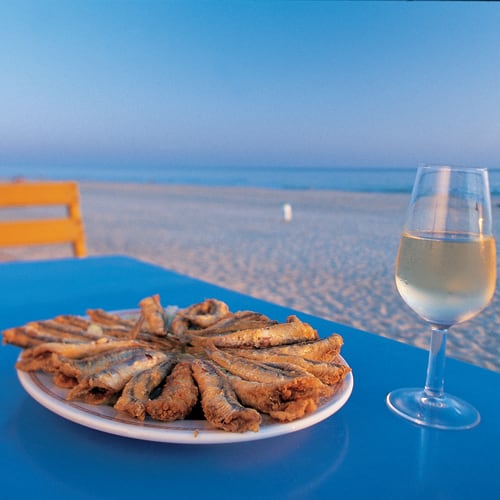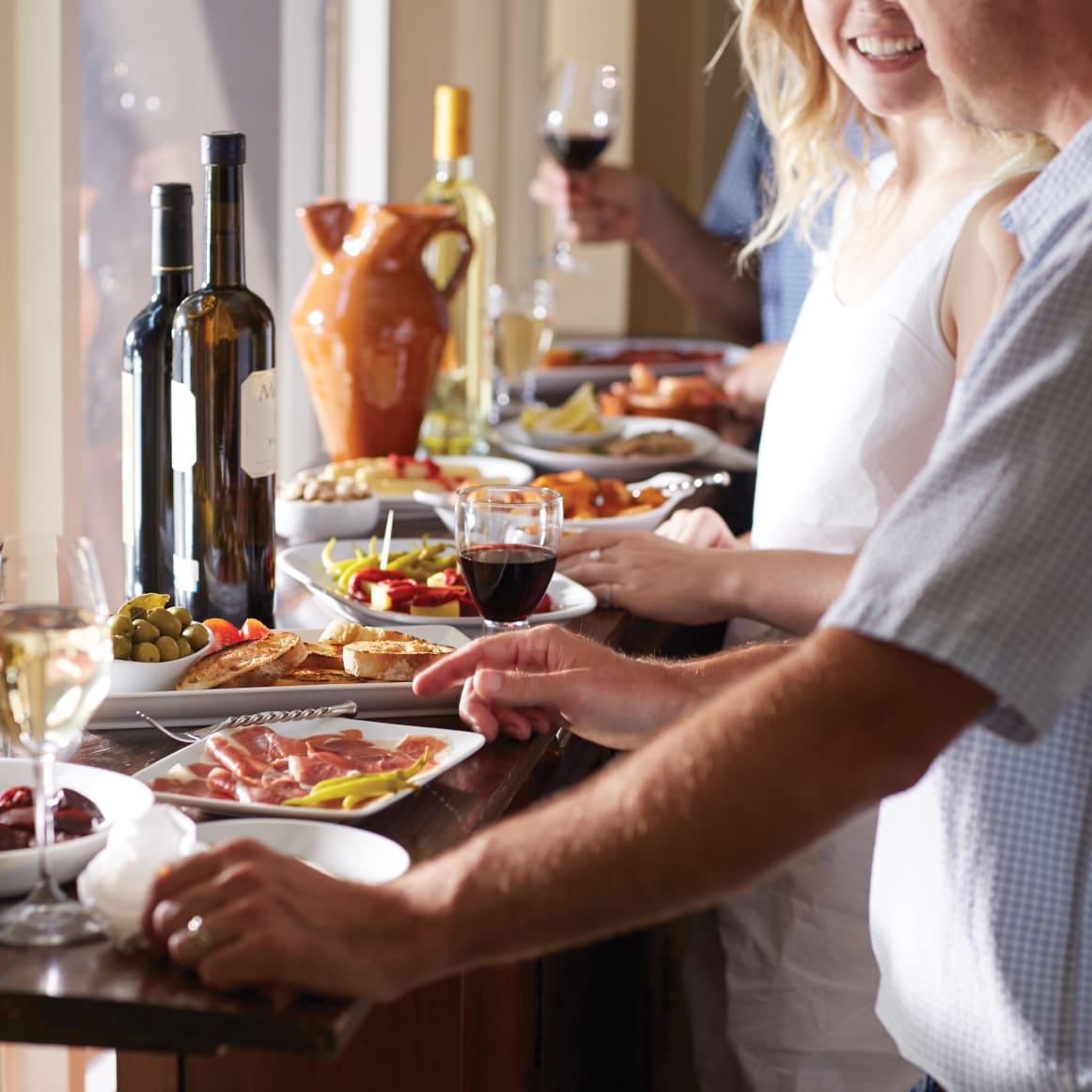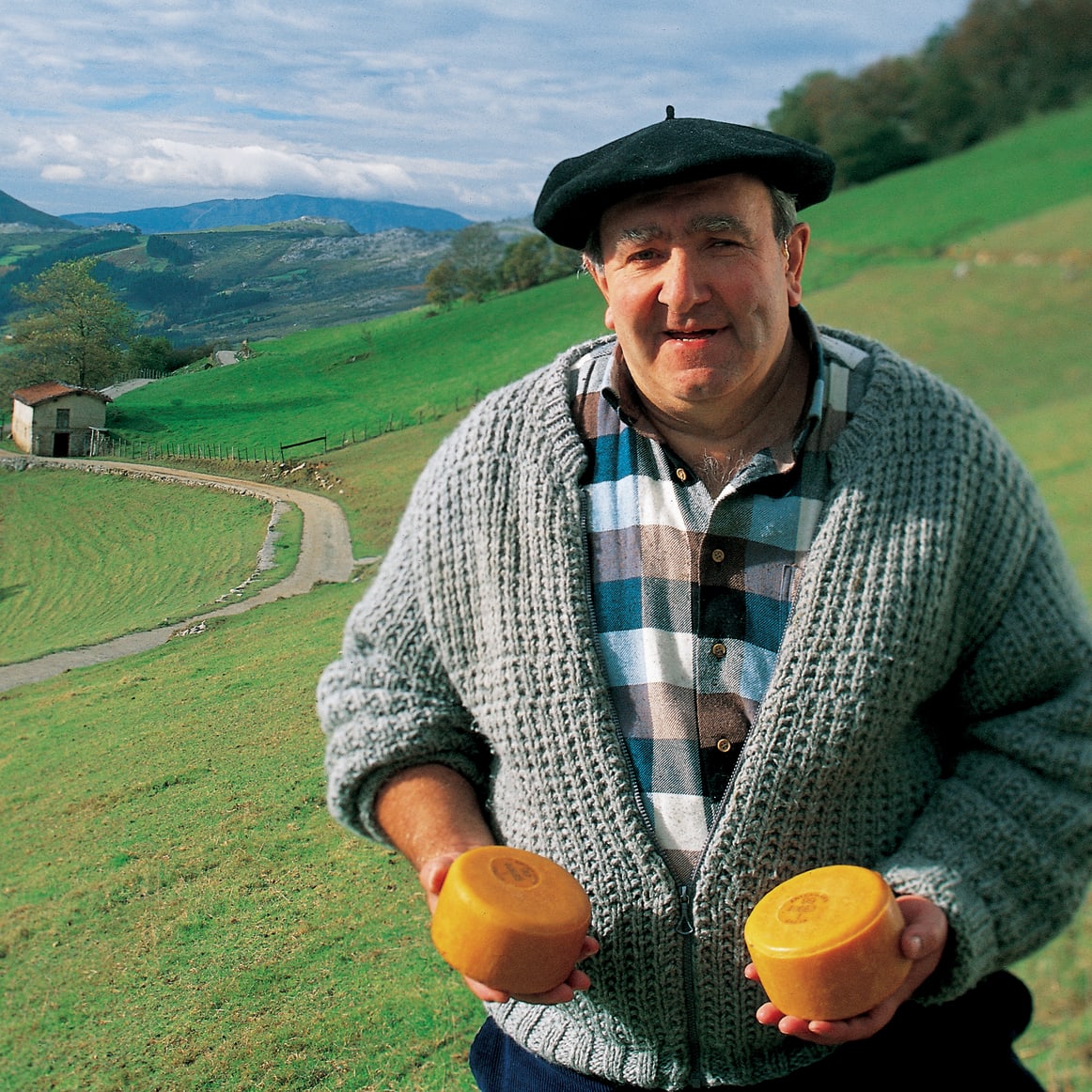An Introduction to the Vibrant Cuisine of Spain
Jonathan Harris | July 2025




When we first lived in Andalucía in the 1970s, our family fell in love with some of Spain’s classic dishes—from churros pastries to refreshing gazpacho and crispy ‘pescaito frito’ fried fish. Over the years we’ve learned we were only scratching the surface of this amazing food culture. Spain's cuisine is a delicious adventure, with a diversity of culinary treasures born of a rich history, varied landscapes and a deep-rooted love of food. Food reflects Spain’s identity, in that it is a celebration of the treasures of each region, and it is central to Spain’s deep sense of community.
A Culinary Melting Pot
Spain’s cuisine is a result of centuries of influences from very different cultures. The Romans introduced olive oil and wine, which are central to Spanish cuisine to this day. The Moors, during their 700-year presence, profoundly influenced the cuisine, bringing foods like rice, almonds, citrus, and spices like saffron, cinnamon and nutmeg. The discovery of the Americas in 1492 brought a wealth of new ingredients that transformed Spanish cooking, including tomatoes, potatoes, peppers and chocolate. All these influences come together in dishes like paella, which incorporates rice and saffron popularized by the Moors, olive oil from the Romans and tomatoes from the Americas.

Spanish Ingredients & Regional Diversity
Spanish cuisine is built on a foundation of fresh, high quality and often locally sourced ingredients. Spain is the world’s biggest producer of olive oil, and this healthy oil is the cornerstone of many dishes. Other crucial ingredients include:
Seafood: Spain is surrounded by the sea and boasts an abundance of fresh fish and seafood. Even in landlocked Madrid, the seafood displays at the market are astonishing in the variety of ultra fresh seafood. Fresh seafood is a key part of the healthy Mediterranean Diet and is part of the recipe for Spaniard’s longevity. Preserved seafood is also important in Spain. Bacalao, or salt cod, is a classic, especially in the Basque Country. Canned fish and shellfish are revered and sometimes cost more than the fresh version.
Pork: Beloved across Spain, pork is featured in a wealth of regional dishes. Familiar cuts like pork chops (chuletas) and tenderloins (solomillos) are popular. But Spaniards enjoy many other cuts, like cheeks (carilleras) and even ears (orejas). Suckling pig, or cochinillo, is a classic north of Madrid in cities like Segovia. In recent years the pork of the iconic Ibérico breed has become available – you must try this pork; it is a meltingly delicious revelation!
Other Meats: Suckling lamb, or cordero lechal, is prized in Castilla y León for its tenderness. Chuletón de buey, or ox steak, is an incredible beef steak from animals up to 12 years old. Chicken is also a common ingredient: I love pollo al ajillo, or garlic chicken, for instance.
Ham: Jamón, and particularly Jamón Ibérico, is Spain’s most treasured food. Legs of ham are hung to dry for up to four years, creating a true ham masterpiece. The ultimate Spanish ham is Jamón Ibérico de Bellota, from pasture-raised Ibérico pigs finished on sweet acorns.
Charcuterie: Cured sausages can be found in every region of Spainespecially smoky, rich chorizos. Like many Spanish foods, every region has its signature flavors. Catalunya is the home of fuet, a mild sausage seasoned with pepper. Mallorca is the birth place of sobrasada, a soft, spreadable chorizo. And there is a cornucopia of other delicious sausages, including butifarra, salchichón, lomo embuchado, caña de lomo and more.
Cheese: Spain boasts hundreds of artisan cheese, to the famous Manchego cheese of La Mancha, to Catalan garrotxa, Galician tetilla and Mahón from the island of Menorca. An amazing number of Spanish cheeses are still made by small families, preserving the ancient traditions of their region.
Vegetables & Beans: Tomatoes, peppers, garlic and onions are fundamental to countless dishes in Spain, from pan con tomate to caldo gallego. Legumes, like chickpeas and beans, are also important, featuring prominently in hearty stews like cocido madrileño.
Rice: An essential Spanish ingredient, rice is featured in paella and many other dishes. Most rice is grown in the Valencia region. Short, grained rice is the most popular, with strains like Senia and Bomba prized for their ability to absorb flavors without breaking apart. We source some of our rice from the mountain village of Calasparra, where paddies are fed by cool mountain waters.
Saffron: Harvested from purple crocus flowers, 1 oz of saffron requires stamens from 4,000 flowers. Saffron adds color and an aromatic flavor to many dishes, like paella and Catalan seafood stew. Don’t worry, it only takes a pinch to add loads of flavor to a recipe.

Spanish cuisine boasts a stunning variety across its seventeen regions, with each area bringing its own unique flavors and cooking methods. From the sun kissed countryside of Andalucía to the lush mountains of Catalunya, each region offers its own culinary treasures. A few examples:
Andalucía: This sunny region in the deep south of Spain is known as the birthplace of tapas and cold soups such as gazpacho and salmorejo. Most Jamón Ibérico comes from this region and pescaito frito, or fried fish, is also a classic.
Valencia: On the Mediterranean coast, Valencia is the birthplace of paella and countless rice dishes. Horchata de chufa is a frosty sweet drink from the region, often served with pastries called fartons. Valencia is famed for its oranges, which make their way into many recipes.
Basque Country: On the far northeast coast of Spain, the Basque Country is famous for seafood dishes including salt cod (bacalao). Pintxos originated here, small bites usually served on bread with a skewer (”pintxo” means “spike” in Basque.) The Basque region also boasts amazing steaks, artisan cheeses, tender Bonito del Norte tuna and the famous Basque cheesecake.
Catalunya: This famous region in eastern Spain offers a rich variety of dishes. Pa amb tomáquet (pan con tomate) is an iconic dish of bread rubbed with tomatoes and drizzled with olive oil. Fideuà is similar to paella but made with pasta noodles instead of rice. And crema catalana is a famous dessert similar to crème brûlée and seasoned with lemon zest and cinnamon.
As you can see from my descriptions of just a few regions, Spain is blessed with a deep variety of dishes and food traditions. After decades of travel across the country, we are still discovering new ingredients and food ways.
Spain’s Most Famous Dishes

Several dishes have become internationally famous and are now ambassadors of Spain’s cuisine:
Paella: A rice dish cooked in a wide pan, traditionally made with rabbit and chicken (paella valenciana), or with fresh seafood.
Tapas: Small plates to be shared, tapas are a cornerstone of Spanish social dining. Often these little bites are served free when you order a beer or wine.
Tortilla Española: A simple yet iconic Spanish omelet made with eggs, potatoes, and often onions. Tortilla is a favorite dish at tapas bars across Spain.
Gazpacho: A refreshing chilled soup made from raw vegetables, like fresh tomatoes and cucumbers, a perfect antidote for a hot summer day.
Patatas Bravas: Fried potatoes served with a mildly spicy tomato sauce and often aioli, this is a tapas bar staple.
Sangría: This refreshing wine cocktail with fresh fruit is now enjoyed across the world.
The Importance of Food Culture in Spain
Food in Spain is about more than just eating; it's central to how Spaniards connect. Meals are a time for gathering with family and friends, fostering connection and community. The tradition of tapas is a perfect example, an opportunity to get together and share conversation and a tasty bite. Mealtimes themselves are celebrated, with a leisurely pace and the cherished practice of sobremesa, the time spent in conversation after the main meal.
Spanish cuisine is a delicious window into the Spanish way of life. From its historical influences and rich regional traditions to its emphasis on fresh ingredients and the sense of community built around great meals, Spanish food culture is a treasure to be experienced. Whether sharing a festive paella, gathering for tapas with friends, or sampling delicacies from the sea, Spain is all about connecting with others around the table. Our family feels privileged to share this amazing culture with you.

¡Hola! I'm Jonathan Harris, one of the owners of La Tienda. I love sharing insights about Spain's amazing food culture.
Learn more >
Related Articles

